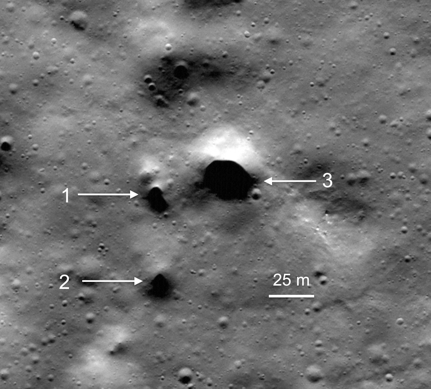Mysterious pits discovered on Moon could be tunnels leading to hidden underground ice
If ice is buried underground, excavators, whether human or robot, now have a much better chance at finding it.

Astronomers have discovered mysterious holes near the Moon's North Pole which they believe could be leading down to an underground tunnel – a passageway that could ultimately take lunar explorers to subsurface ice deposits if they exist.
The pits in question here were discovered by astronomers assessing images from NASA's Lunar Reconnaissance Orbiter (LRO). They appear as small, rimless depressions in the 70-km wide Philolaus Crater, just 550km away from the satellite's North Pole.
Though the images captured do not reveal what's inside these pits, except for a dark shadowed interior, the researchers involved in the discovery think these 15-30m wide holes are skylights or entrances that might lead lunar explorers to lava tubes or hidden underground passageways that were filled with lava during our Moon's early days.

These tunnels, as the researchers say, could be the ultimate key to finding lunar ice deposits -- an easily accessible source of usable water for those planning to set up a base on Earth's closest neighbour in the future.
"The highest resolution images available for Philolaus Crater do not allow the pits to be identified as lava tube skylights with 100 percent certainty, but we are looking at good candidates considering simultaneously their size, shape, lighting conditions and geologic setting," said Pascal Lee, the researchers who made the new finding.
Astronomers have already discovered some 200 similar pits on the Moon but the latest finding holds much more importance, particularly because of its location. These are the first pits to be identified in the permanently shadowed areas near the poles, where water ice may have accumulated in the past.
Simply put, if ice is buried underground, excavators, whether human or robot, now have a much better chance at finding it.
The latest finding comes as Nasa considers possible sites for a future mission to the Moon. However, this is only half work done. The researchers now plan to "verify if these pits are truly lava tube skylights and if they are, whether the lava tubes actually contain ice".
If that's true and the site is further explored sometime in future, astronomers could not only gain access to water but also get new insights into the Moon and its historical evolution.
Not to mention, the implications of the study will go beyond Moon. "Exploring lava tubes on the Moon will also prepare us for the exploration of lava tubes on Mars," Lee added. "There, we will face the prospect of expanding our search for life into the deeper underground of Mars where we might find environments that are warmer, wetter, and more sheltered than at the surface."





















